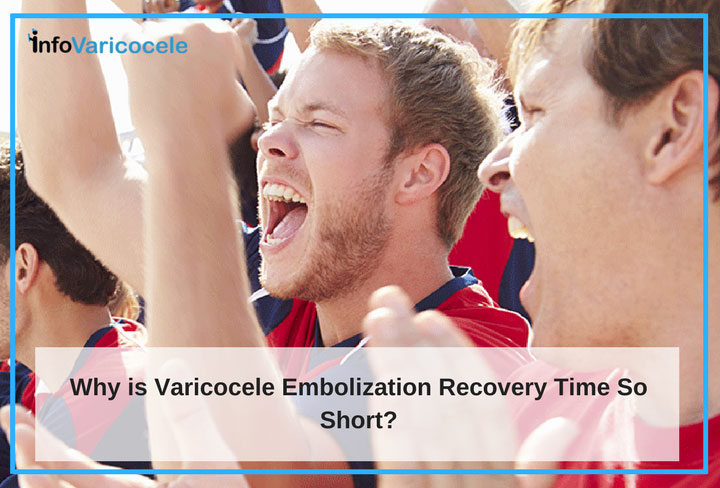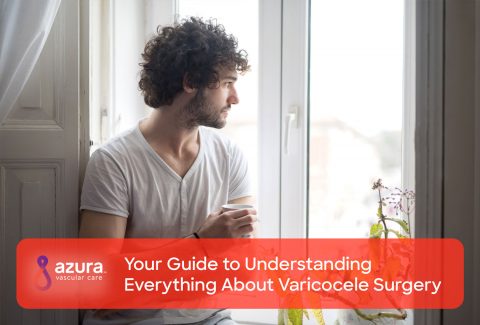
Nobody wants to make time for an extensive recovery period after having surgery. Men afflicted with varicocele want nothing more than to have a quick procedure and to recover, returning to their families, daily life, and work as soon as possible. For men trying to start a family? Timing can become even more important. Varicocele treatment can consist of either surgery or a minimally invasive technique known as varicocele embolization. Varicocele treatments can vary in recovery times, so it’s important to understand the distinctions before you and your doctor choose one that’s right for you.
Comparing Varicocele Treatment Options
When comparing the various varicocele treatment options, you have to look at each procedure, the factors that affect recovery, and the estimated recovery time. There are 2 basic types of treatment for varicocele veins:
1. Surgical – surgery options involve 3 types of procedures. Some can be done as an outpatient procedure, but generally these more invasive procedures are done in the hospital.i
- Open
- Microsurgical
- Laparoscopic surgery
2. Varicocele Embolization – a minimally invasive procedure performed by an interventional radiologist as an outpatient procedure.ii
Factors Affecting Surgical Recovery
There are two primary factors that affect estimated surgery and varicocele embolization recovery time: how invasive the procedure is and the sedation that is necessary.
Invasiveness of Procedures
- Open surgery involves cutting into the groin area so the doctor can physically tie off the affected veins.
- Microsurgical procedures also involve cutting into the groin, but the difference between this and open surgery is that doctors utilize a microscope to isolate the dysfunctional veins, making the procedure less invasive. Surgeons still must tie off the veins.
- Laparoscopic surgery still requires surgeons to make incisions in the groin. However, the incision is smaller. Robotic instruments are used to physically repair the dysfunctional veins. iii
- Percutaneous embolization (varicocele embolization) involves only a small nick to the skin where a catheter is inserted by an intervention radiologist. Metal coils, and possibly a sclerosing solution, are inserted through the catheter to close off the affected vein from further blood flow. iv
Sedation Involved in Procedures
Sedation plays a primary role on whether a patient is discharged from an outpatient procedure or required to stay in a hospital. It also affects post-surgical outcomes.
- Open surgery can be done under either general or local anesthesia.
- Microsurgical surgery can be done under either general or local anesthesia.
- Laparoscopic surgery requires general anesthesia because of the robotic equipment and precision required. Since general anesthesia is necessary, patients often need to stay overnight in the hospital.vi
- Percutaneous embolization involves only a local anesthetic and mild sedation, if the patient requests it, resulting in an outpatient procedure that allows the patient to be discharged to their home the same-day.
Recovery Times For Each Treatment Option
- Open Surgery – up to 2 weeks for strenuous activity and 4 weeks for sexual activity.
- Microsurgical Surgery – 1 week for strenuous activity and 4 weeks for sexual activity.
- Laparoscopic Surgery – 2 weeks for strenuous activity and 4 weeks for sexual activity.
- Varicocele Embolization – 1-2 days for strenuous activity and 1-2 weeks for sexual activity.
Risk Factors of Procedures
There are always some risks associated with any medical procedure. However, new technology greatly reduces these risks as advances in techniques have dramatically reduced the necessity for invasive procedures and sedation. Below is a list of some of the risks associated with varicocele correction procedures.
Surgery – all surgeries, even those with a minimal incision, have some additional risks. The primary risk of any surgical procedure is infection, which is directly related to the incision. Other risks may include:
- Testicular atrophy
- Artery damage
- Hydrocele formation (a buildup of fluid around testicles) vii
RELATED: Varicocele Surgery Complications You Should be Aware Of
Varicocele Embolization – the primary risk in varicocele embolization is in the needle stick. Because it pricks the skin, there is a small risk of infection, but most of the medical community overwhelmingly agrees the risk is extremely minimal. Other risks may include:
- Temporary pain in the flank area
- A reaction to the contrast solutions used
- Arterial puncture
- Migration of embolizing materials viii
Success Rates
Surgery – sometimes results in reoccurrences of the varicocele. Studies indicate one in 10 will have a reoccurrence, although most medical professionals agree the laparoscopic surgical approach offers the best chance for success.
Embolization – has a 90 percent success rate and is sometimes even used to correct reoccurrence of the varicocele that occur after surgical procedures are performed.ix
Better Understanding of The Differences
It’s important to understand why some treatment options require a more extensive recovery time than others, so you can make an informed decision. Today, there are excellent options for men with varicocele veins. New minimally invasive procedures like varicocele embolization are often an ideal option for men because they offer exceptional results, but with less required recovery time. Be sure you do your research before making a final decision.
Sources:
i http://www.mayoclinic.org/diseases-conditions/varicocele/basics/treatment/con-20024164
ii http://www.mayoclinic.org/diseases-conditions/varicocele/basics/treatment/con-20024164
iii http://www.hopkinsmedicine.org/minimally_invasive_robotic_surgery/types.html
iv http://www.mayoclinic.org/diseases-conditions/varicocele/basics/treatment/con-20024164
v http://ether.stanford.edu/asc/documents/discharge2.pdf
vi http://www.sirweb.org/news/newsPDF/facts/Male_Infertility-Varicoceles_fact_sheet.pdf
vii http://www.mayoclinic.org/diseases-conditions/varicocele/basics/treatment/con-20024164
viii http://www.ncbi.nlm.nih.gov/pmc/articles/PMC3114590/
ix http://www.ncbi.nlm.nih.gov/pmc/articles/PMC3381493/


